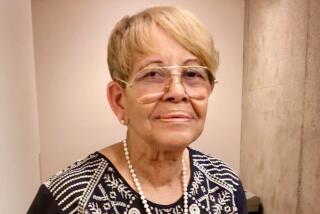2 Doctors Who Overcame Sexism
- Share via
She was one of a handful of determined Los Angeles women who overcame personal hardships and the 19th century’s endemic sexism to win a place in the medical profession.
In fact, Rose Talbot Bullard’s perseverance against an all-male medical establishment ultimately made her the Los Angeles County Medical Assn.’s first female president. It was a measure of her singular achievement that no other woman would fill that post for another 90 years.
A specialist in gynecology, obstetrics and pediatrics, Bullard was one of the first physicians in Los Angeles to use spinal anesthesia in obstetrics. Her surgical skills were so well recognized that she was elected a fellow--one of only eight women--of the newly formed American College of Surgeons.
It was an era in which the practice of medicine was considered more an art than a science, and a female doctor could win grudging acceptance as a peer--as long as she confined her practice to suitable patients: other women and their children.
Still, there were sympathetic voices: “What men have done for science, women will do for suffering humanity,” predicted one 19th century male physician.
Born in Birmingham, Iowa, in 1864, Rose helped her father, the town doctor, make house calls in their horse and buggy. With help from her socially prominent family and her older brother, who had already completed medical school, Rose was accepted at the Women’s Hospital Medical College in Chicago--later absorbed by Northwestern University Medical School--then one of 17 American medical colleges for women.
But soon after school began, her father died, and she paid for her medical education by working as a registered nurse.
The West offered women more access to education, and the Talbot family moved to Los Angeles in 1885, where Rose’s sister, Lula, would become the first female graduate of USC’s College of Medicine.
Lula began attending coed classes with only one other woman, who would soon drop out. The class of 20 met at the old two-story home of French immigrant Louis Vignes on Aliso Street.
She soon found that her classmates delighted in skillfully arranging a male cadaver in an embarrassing position, and a professor opened the first day of class by lecturing on male syphilitic sores, to see her reaction.
Lula was undeterred.
One classmate, future ear, nose and throat specialist H. Bert Ellis, took it upon himself to guard her against chauvinistic classmates and soon found himself head over heels in love.
Soon there were two Doctors Talbot in Los Angeles. Rose, who had bested her Chicago classmates to become valedictorian, arrived in Los Angeles with her new medical degree during the smallpox epidemic of 1886. Two years later, Lula became a physician too.
No sooner had Rose arrived than her sister introduced her to a classmate, Frank Bullard, who was specializing in ophthalmology and anesthesiology.
As the physician foursome double-dated, Rose busied herself setting up a partnership with Dr. Elizabeth Follansbee, the great-granddaughter of Connecticut’s Roger Sherman, a signer of both the Declaration of Independence and the Articles of Confederation.
Follansbee, one of the all-female founders of Children’s Hospital in San Francisco, was the first female member of the Los Angeles County Medical Assn. and a professor specializing in diseases of children at Los Angeles’ tiny College of Medicine, a position she would hold for 23 years.
For two years, their practice attracted a large clientele to their office on Broadway between 2nd and 3rd streets.
On May 3, 1888, a few hours after Lula, her beau and Rose’s boyfriend all graduated from medical school, the couples married in a double-ring ceremony, the first ever to be held among four physicians in Los Angeles.
Combining honeymooning with research, the quartet of doctors took off for Germany and Vienna. Returning a year later, the Bullards soon opened a practice at 8th and Alvarado streets and collaborated on a variety of medical research.
Before Rose gave birth to her daughter, Helen--who would also become a physician--she wrote medical articles for the Southern California Practitioner, including one on the use of electricity in gynecology.
Many of her female patients suffered from what was routinely diagnosed as hysteria, then considered a uterine disorder called “womb furies” or “congested genitalia,’ which supposedly derived from a lack of sexual satisfaction.
For those women, a device making its debut in the 1880s was the vibrator, a medical device that became the fifth electric household gadget for which a U.S. patent was granted, following the sewing machine, fan, teakettle and toaster.
But before it became common in homes, the device became a therapeutic staple in Rose’s office.
She succeeded her husband as president of the county medical association in 1902--winning with 14 votes to her two male opponents’ combined total of 13. Under her leadership, the group’s members generated more medical and scientific papers, and membership increased to 200 for the first time.
One scientific paper, “Electrical Wire Burns,” reported the city’s first case of accidental electrocution.
Rose died in 1915, at age 51, from complications of an infected tooth. Her husband married their office secretary.
Lula never made the kind of medical mark her sister achieved, but continued to specialize in nutrition therapy.






